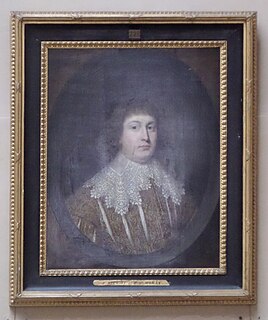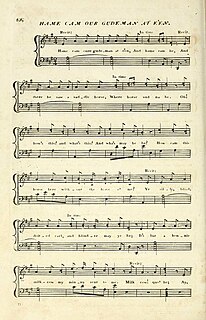
"The Bonnie Earl o' Moray" (Child 181, [1] Roud 334 [2] ) is a popular Scottish ballad, which may date from as early as the 17th century. [3]

"The Bonnie Earl o' Moray" (Child 181, [1] Roud 334 [2] ) is a popular Scottish ballad, which may date from as early as the 17th century. [3]

The ballad touches on a true story stemming from the rivalry of James Stewart, Earl of Moray (pronounced Murray), and the Earl of Huntly, which culminated in Huntly's murder of Moray in 1592. The exact circumstances that led to the murder are not known for certain, but both their families, the Stewarts of Doune (pronounced "doon") and the Gordons of Huntly, had a history of territorial rivalry and competition for royal favour. In his notes on the ballad, Francis James Child relates how Huntly, eager to prove that Moray was plotting with the Earl of Bothwell against King James VI, received a commission to bring Moray to trial. In the attempt to apprehend Moray, the earl's house at Donibristle in Fife was set on fire and the visiting Sheriff of Moray killed. Moray fled the house, but was chased and killed in its grounds, betrayed, it was said, by the glow of his burning helmet tassle. His last words, according to the (probably apocryphal) story related by Walter Scott, deserve special mention. Huntly slashed him across the face with his sword, and as he lay dying Moray said "Ye hae spilt a better face than yer ain" ("You have spoiled a better face than your own"). The killing was widely condemned. Moray's mother, Margaret Campbell, had a painting made of her son's dead body, as evidence of his multiple wounds, bearing the legend "God Revenge My Caus". Her intention was to show this publicly at the Cross in Edinburgh, but the King ignored her request, effectively withholding permission. [4]

The King's reaction in the ballad is to condemn Huntly's action (in verse 2):
Nevertheless, James did not punish Huntly, prompting rumours of his own complicity in the murder. It is possible that the inclusion of the King's clear condemnation of the deed (whether or not it was ever expressed by him) was an effort to prevent the ballad from appearing treasonous. However, we can discount the ballad's claim that Moray was the Queen's lover (hinting at a possible motive for James's complicity). [5] The ballad, which praises Moray as "a braw gallant" (Scots, calland) [ citation needed ], was most likely composed by one of his supporters[ citation needed ]. The words "Oh he might have been a king!" should not be taken to imply that he could have become King [ citation needed ]. More likely, they conveyed the sense that he possessed the required attributes of a king and so could easily have been one.
It is from the first verse of "The Bonnie Earl o' Moray" that the term mondegreen, meaning a misheard lyric, came into popular use among folk musicians.
When the ballad is sung in Scots, the form is different from the more anglicised version in the Child catalogue. For example, the verses given above are sung with these words:
A German translation by Johann Gottfried Herder, Murrays Ermordung, published 1778–79, was set to music by Johannes Brahms in 1858. [6] The ballad was also set to music by Hugh S. Roberton and Benjamin Britten.
The American writer Sylvia Wright coined the term "mondegreen" in an essay "The Death of Lady Mondegreen," which was published in Harper's Magazine in November 1954. [7] In the essay, Wright described how, as a young girl, she misheard the final two lines of the above verse as "they have slain the Earl o' Moray, and Lady Mondegreen." She said that she always imagined the Earl dying beside his faithful lover "Lady Mondegreen", and refused to hear the real words, because they were less romantic than her misheard version. The term "mondegreen" has since been adopted for any misheard song lyric which changes the meaning of the original.
Versions of the ballad can be heard on Isla St Clair's album Great Songs and Ballads of Scotland and Irish-American singer Robbie O'Connell's album Close to the Bone. It was also recorded by Robin Hall and Jimmie Macgregor for the album Scottish Choice (1961). Live version recorded by The Corries on their album "Live from Scotland Volume 4" (1977).
English composer Benjamin Britten arranged the song for voice and piano sometime before 11 December 1940, and included it in the first volume of his folk song arrangements. [8]
A mondegreen is a mishearing or misinterpretation of a phrase in a way that gives it a new meaning. Mondegreens are most often created by a person listening to a poem or a song; the listener, being unable to hear a lyric clearly, substitutes words that sound similar and make some kind of sense. The American writer Sylvia Wright coined the term in 1954, recalling a childhood memory of her mother reading the Scottish ballad "The Bonny Earl of Murray", and mishearing the words "layd him on the green" as "Lady Mondegreen".

James Stewart, 1st Earl of Moray was a member of the House of Stewart as the illegitimate son of King James V of Scotland. A supporter of his sister Mary, Queen of Scots, he was the regent of Scotland for his half-nephew, the infant King James VI, from 1567 until his assassination in 1570. He was the first head of government to be assassinated with a firearm.
George Gordon, 1st Marquess of Huntly was a Scottish nobleman who took a leading role in the political and military life of Scotland in the late 16th century, and around the time of the Union of the Crowns.

The title Earl of Moray, Mormaer of Moray or King of Moray was originally held by the rulers of the Province of Moray, which existed from the 10th century with varying degrees of independence from the Kingdom of Alba to the south. Until 1130 the status of Moray's rulers was ambiguous and they were described in some sources as "mormaers", in others as "Kings of Moray", and in others as "Kings of Alba". The position was suppressed by David I of Scotland some time after his defeat of Óengus of Moray at the Battle of Stracathro in 1130, but was recreated as a feudal earldom by Robert the Bruce and granted to Thomas Randolph, 1st Earl of Moray in 1312.

Auchindoun Castle is a 15th-century L-Plan tower castle located in Auchindoun near Dufftown in Banffshire, Scotland.
James Stewart, Earl of Moray was a Scottish nobleman and diplomat.

James Stewart, 2nd Lord Doune, 2nd Earl of Moray was a Scottish nobleman, the son of James Stewart, 1st Lord Doune and Margaret Campbell. He was murdered by George Gordon, Earl of Huntly as the culmination of a vendetta. Known as the Bonnie Earl for his good looks, he became the subject of a popular ballad, "The Bonnie Earl of Moray".
"Geordie" is an English language folk song concerning the trial of the eponymous hero whose lover pleads for his life. It is listed as Child ballad 209 and Number 90 in the Roud Folk Song Index. The ballad was traditionally sung across the English speaking world, particularly in England, Scotland and North America, and was performed with many different melodies and lyrics. In recent times, popular versions have been performed and recorded by numerous artists and groups in different languages, mostly inspired by Joan Baez's 1962 recording based on a traditional version from Somerset, England.
"Young Hunting" is a traditional folk song, Roud 47, catalogued by Francis James Child as Child Ballad number 68, and has its origin in Scotland. Like most traditional songs, numerous variants of the song exist worldwide, notably under the title of "Henry Lee" and "Love Henry" in the United States and "Earl Richard" and sometimes "The Proud Girl" in the United Kingdom.
"The Bonny Hind" is Child ballad number 50.
"Babylon" or "The Bonnie Banks o Fordie" is Child ballad 14, Roud 27.
Mr. Motherwell gives a version under the title of Babylon; or, the Bonny Banks o' Fordie; and Mr. Kinloch gives another under the title of The Duke of Perth's Three Daughters. Previous editors have attempted to find a local habitation for this tradition, and have associated it with the family of Drummond, of Perth. As a legend exactly similar is current in Denmark. this appears a bootless quest.

"Our Goodman" is a Scottish and English humorous folk song. It describes the efforts of an unfaithful wife to explain away the evidence of her infidelity. A version of the song, "Seven Drunken Nights", was a hit record for The Dubliners in the 1960s.
"Lizie Wan" is Child ballad 51 and a murder ballad. It is also known as "Fair Lizzie".

"The Bonnie Banks o' Loch Lomond", or "Loch Lomond" for short, is a Scottish song. The song prominently features Loch Lomond, the largest Scottish loch, located between the council areas of West Dunbartonshire, Stirling and Argyll and Bute. In Scots, "bonnie" means "attractive", "beloved", or "dear".

The Battle of Glenlivet was a Scottish clan battle fought on 3 October 1594 near Glenlivet, Moray, Scotland. It was fought between Protestant forces loyal to King James VI of Scotland who were commanded by Archibald Campbell, 7th Earl of Argyll, against Catholic forces who were commanded by George Gordon, 6th Earl of Huntly, and Francis Hay, 9th Earl of Erroll. The Catholics won a decisive victory in the battle, but in the aftermath were subdued by King James.
"The King's Dochter Lady Jean" is Child ballad No. 52.
The Bonnie House of Airlie is a traditional Scottish folk song of the seventeenth century, telling the tale of the raid by Archibald Campbell, Earl of Argyll, on Airlie Castle, the home of James Ogilvy, Earl of Airlie, in the summer of 1640. A broadsheet version first appeared in 1790 and it received formal publication as number 199 in Francis Child's collection The English and Scottish Popular Ballads of 1882.
The (Bonnie) Rantin' Laddie or Lord Aboyne is a traditional Scottish folk ballad telling of the valiant rescue of his lover by a noble Highland lord.

Agnes Keith, Countess of Moray was a Scottish noblewoman. She was the wife of James Stewart, 1st Earl of Moray, regent of Scotland and the illegitimate half-brother of Mary, Queen of Scots, making her a sister-in-law of the Scottish queen. As the wife of the regent, Agnes was the most powerful woman in Scotland from 1567 until her husband's assassination in 1570.
Cam ye o'er frae France? is a Scots folk song from the time of the Jacobite rebellions of the 18th century. It satirises the marital problems of the Hanoverian George I.